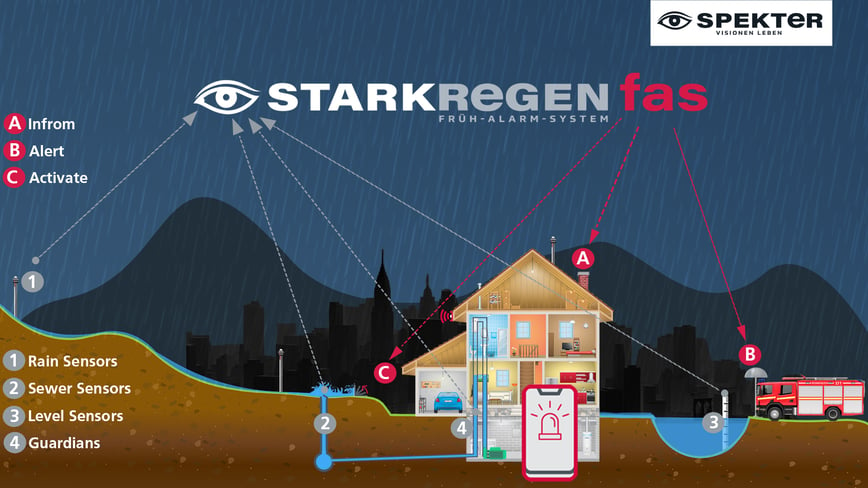"Heavy rainfall events" are occurring ever more often as a result of climate change and they are causing more and more damage. Additional efforts are required to protect life, property and infrastructure of towns and cities. The heavy rainfall early warning system can help decisively minimize damage.
On May 19, 2022, Mundelsheim local council gathered in the meeting chamber of the historic town hall. The council began its deliberations at 7 p.m. while outside a hailstorm was approaching. Nobody inside knew anything about what was going on in the locality until a frantic local burst into the meeting with the news that "The entire village was flooding!". As the councilors then stepped outside, brown murky water was already raging through the middle of the village.
Localized storms such as this or even supercells are no longer isolated incidents. Eleven people lost their lives in the towns of Braunsbach and Simbach in 2016. In the summer of 2021, a violent thunderstorm struck Oberdorfen in the Upper Bavarian district of Erding – 50 liters of rain per square meter was sufficient to flood the entire village, leaving homes temporarily uninhabitable. And even "once-in-a-century-floods" occur every few years, as the multiple floods in localities such as Grimma (Mulde), Dresden (Elbe) and Deggendorf (Danube) demonstrate. And cities such as Cologne (Rhine) or Passau (Danube, Inn and Ilz) located on the banks of rivers are affected regularly.
Urgent need for action locally
Improved weather forecasting on its own is of no use. In an attribution study produced after the Ahr Valley disaster, Hayley Fowler, Professor of Climate Change Impacts at Newcastle University, demands parallel measures. Besides cutting greenhouse gases as fast as possible to mitigate the trend, she points to the need to improve warning systems and disaster management. In addition, the infrastructure also needs to be made "climate-resilient." Her colleague Dr. Frank Kreienkamp, Head of the Regional Climate Office Potsdam at the German Meteorological Service, points out in the same study that local and national government agencies must take greater account of the growing risks due to heavy rainfall.
Because often the focus is on flooding and river management, the consequences of heavy rainfall tend to be ignored. This transforms not only "inconspicuous" watercourses, but also dirt tracks and streets into raging torrents. Such risks must be considered much more if we are to combat the changing threat situation with suitable measures. Here in particular the aim is to gain time: Detecting the dangerous situation, alerting people in good time and therefore facilitating preparations by the emergency services and allowing individuals to protect themselves.
EWS – the solution to the dilemma
This is precisely where the Smart City Team from EDAG Production Solutions (EDAG PS) comes in.
Together with cooperation partner Spekter from Herzogenaurach, EDAG PS operates its heavy rainfall early warning system (EWS). The environmental tech company focused on heavy rainfall risk management has developed a comprehensive, multi-stage concept to identify heavy rain risks early on and to warn government agencies, emergency services and the population.

In an initial step, a risk analysis is produced for the area to be protected. A range of heavy rainfall events are analyzed and tested in 2D and 3D simulation processes to determine how the water drains away in the particular case. Based on these maps, construction measures and disaster management scenarios can be developed.
The heavy rainfall early warning system is based on sensors, on the one hand, that record live the levels of small and large rivers as well as neuralgic points in the sewage system. The recorded values are supplemented with meteorological data from the German Meteorological Service (DWD) and the Flood Warning Service (HND). The obtained information on the current and expected weather phenomena is analyzed in real time. When critical levels are reached, local residents are alerted along with those responsible in local councils and emergency services.
Lighthouse project in the district of Fulda
The EWS is already up and running in certain towns and cities in various configurations. At present, the multi-stage "eRisk management project for an early warning system for heavy rainfall" is being rolled out in the district of Fulda in Hesse. Initially restricted to the four pilot towns of Eichenzell, Ebersburg, Burghaun and Neuhof, the aim is to make the system available to all 19 towns and cities by the end of 2023. Extending the early warning system solution across the entire district also constitutes an unprecedented project size for the system manufacturer. Collaboration with EDAG PS as implementation partner made this kind of scaling possible in the first place.
EDAG PS has assumed project management for the EWS rollout as general contractor and is therefore the first port of call for customers, for instance with implementation of the sensors in consultation with the towns and the service yards. 200 sensors in sewers, on bridges, in public buildings and on rivers will be installed by the end of 2023. The sensors are fully automated, and make various measurements including rainfall, river levels and drainage behavior.
In addition, EDAG PS has developed an important element of the project with the digital heavy rainfall participation platform. The interactive website allows residents throughout the entire Fulda district to report hazardous situations that have already occurred. This further supplements the information from the installed sensors..png?width=868&height=728&name=MicrosoftTeams-image%20(12).png)
Projects are funded by central and regional governments
Central and regional governments have also been alarmed by the frequent tendency to underestimate heavy rainfall events, even though these will presumably become more frequent as part of climate change and cause even greater destruction. In response, a whole range of funding programs have been created to provide rapid remedies. The project in the district of Fulda, for instance, is being funded to the tune of €830,000 by the regional Hesse government as part of the "Strong Home Hesse" program.
Advice regarding potential financial support also constitutes an important aspect of the customer support at EDAG PS. The experts are familiar with the various sources of funding which help towns tackle such projects. Ultimately, EDAG PS has already garnered extensive experience. Over the past five years, the company has been supporting these concepts as part of its Smart City strategy, with many satisfied customers to its name.
Would you also like to protect your towns better from the consequences of heavy rainfall? If you have any questions on the "Heavy rainfall early warning system" in Fulda or on the EWS solution from Spekter, then do not hesitate to contact Karina Schäfer. The Business Development Manager Smart City at EDAG PS has already overseen some successful projects with the heavy rainfall early warning system. Or download our white paper "Helping towns defy the forces of nature" that includes additional details.






